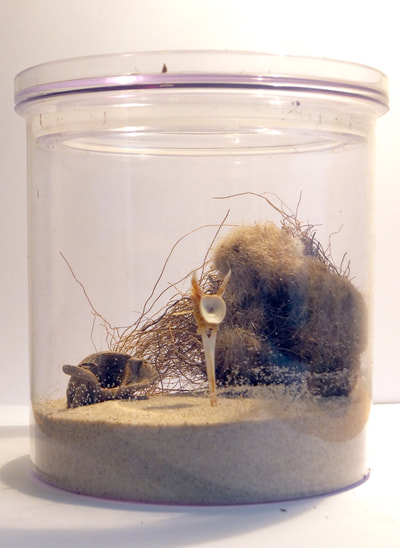Landscapes of Antropocene
Installation view in Baltic Gallery of Contemporary Art
Artworks © Natalia Bazowska. All rights reserved.
Pejzaże Antropocenu
Widok wystawy w Bałtyckiej Galerii Sztuki Współczesnej
Prace © Natalia Bazowska. Wszelkie prawa zastrzeżone.
Photo by BGSW Slupsk
Zdjęcia BGSW Słupsk
Link to Baltic Gallery of Contemporary Art
Link do Bałtyckiej Galerii Sztuki Współczesnej
|
The exhibition focuses on human impact on the natural environment, which has become gradually and irreversibly degraded as a result of cultural annexation and interference. Once, stable climatic conditions, especially the constant temperature over the past 12,000 years, were conducive to the development of agriculture and the settlement of migratory communities. This, however, changed in the 17th century, when the Western culture engaged in the scientific revolution applied the paradigm of the so-called “Conquest of Nature” which was supported by such philosophical authorities as Francis Bacon, who argued that nature was created by God, and then made available to people “to alleviate their needs.” That view was reinforced by the industrial revolution initiated in the 18th century, which brought an irreversible conflict between man and nature. The previous geological era, which had lasted for almost 2.5 million years, ended with the emergence of the industrial civilization in the last century. Geologists define the new phase in the Earth’s history as the Anthropocene, or sometimes the New Human Age. These transformations have also entered the realm of literature (from Charles Dickens, Emil Zola and Henry David Thoreau to Anna Dillard and Olga Tokarczuk) and visual arts – the latter revealing both the state of mind of the artist observing the changing nature (Turner, Monet), and the nature of the object instrumentally interfering with the world of fauna and flora (Michael Heizer, Damien Hirst). It is symptomatic that a significant part of these exemplifications proves that we have become accustomed to, or perhaps even enchanted by climate change. In art, we are more frequently observing critical reflections on the degradation of the natural environment which stimulate the audience to change their perception of the human presence in the world. The exhibition Landscapes of the Anthropocene attempts to describe this phenomenon.
Curator: Roman Lewandowski |
Projekt wystawienniczy poświęcony jest problematyce oddziaływania człowieka na środowisko naturalne, które w rezultacie kulturowych aneksji i ingerencji uległo stopniowej i nieodwracalnej degradacji. Stabilne warunki klimatyczne, a zwłaszcza występowanie stałej temperatury na przestrzeni minionych 12 tys. lat było czynnikiem sprzyjającym rozwojowi rolnictwa i osiedlaniu się wędrownych społeczności. Constans ten został jednak podważony w XVII w., kiedy kultura Zachodu w ramach rewolucji naukowej wypracowała paradygmat tzw. „podboju natury”, który wsparły m.in. takie autorytety filozoficzne, jak Francis Bacon, dowodzący, że natura została stworzona przez Boga, a następnie udostępniona ludziom „dla ulżenia ich potrzebom”. Zwieńczeniem tego stanowiska stała się zapoczątkowana w XVIII w. rewolucja przemysłowa, która przyczyniła się do nieodwracalnego skonfliktowania człowieka ze środowiskiem naturalnym. Ostatnia, trwająca bez mała 2,5 miliona lat epoka geologiczna – w konsekwencji zaistnienia cywilizacji industrialnej – w minionym stuleciu dobiegła kresu. Nową fazę w dziejach Ziemi geologowie zdefiniowali jako tzw. antropocen, nazywany niekiedy Nową Ludzką Epoką. Przeobrażenia te stały się także tematem zarówno wielu dzieł literackich (począwszy od Karola Dickensa, Emila Zoli i Henry’ego Davida Thoreau, a skończywszy na Annie Dillard czy Oldze Tokarczuk) jak i podejmowane są w sztukach wizualnych, które jednocześnie uwidaczniają specyfikę artysty obserwującego zmieniającą się naturę (Turner, Monet), jak i podmiotu instrumentalnie ingerującego w świat fauny oraz flory (Michael Heizer, Damien Hirst). Symptomatyczny jest fakt, że znacząca część tych egzemplifikacji dowodzi zarówno oswojenia czy nawet zauroczenia zmianami klimatycznymi, jak i coraz częściej mamy do czynienia ze sztuką w sposób krytyczny podejmującą refleksję nad degradacją środowiska naturalnego i stymulującą zmianę myślenia o naszym byciu w świecie. Wystawa „Pejzaże antropocenu” ma stanowić próbę opisania tego zjawiska.
Kurator: Roman Lewandowski |
Related works
Powiązane prace
Powiązane prace




